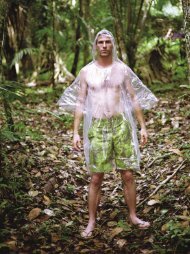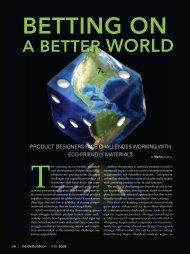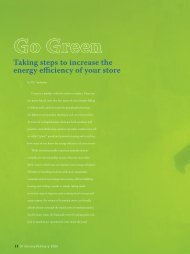Fall - InsideOutdoor Magazine
Fall - InsideOutdoor Magazine
Fall - InsideOutdoor Magazine
You also want an ePaper? Increase the reach of your titles
YUMPU automatically turns print PDFs into web optimized ePapers that Google loves.
”Many synthetic fabrics in the market claim to<br />
have the ability to move moisture away from the body<br />
to the outside of the fabric,” says David Earley, Cotton<br />
Incorporated’s director of supply chain marketing. “But<br />
most do nothing more than absorb perspiration into<br />
the fabric, staying as wet on the inside of the garment<br />
as they are on the outside.”<br />
According to Earley, Cotton Incorporated spent<br />
the past year conducting moisture management<br />
testing to gauge the performance advantage of<br />
TransDRY technology, utilizing testing equipment,<br />
called the MMT Tester, from SDL Atlas in the United<br />
Kingdom. Originally developed by Hong Kong<br />
Polytechnic University, the MMT Tester has the ability<br />
to measure the differential wetness of both sides of a<br />
performance fabric and calculate a one-way moisture<br />
transfer index.<br />
“Fabrics engineered to have one-way transfer<br />
performance beat any synthetic product we’ve tested<br />
in head-to-head comparisons – it’s not even close,” says<br />
Earley. “We think this is an incredible breakthrough for<br />
cotton in the world of performance apparel that will<br />
help us compete head-to-head with synthetics.”<br />
Longworth Industries, an American manufacturer<br />
of high-tech performance apparel and base layer<br />
garments, will be the first to bring a TransDRY product<br />
to market under its new PolarMax Naturals brand.<br />
Longworth has been field testing prototype garments<br />
with branches of the military to gauge performance<br />
and acceptability of the TransDRY technology. The<br />
consumer market will be next up, says Trey Harris,<br />
Longworth’s senior director of business development<br />
“At the end of the day, people just like wearing<br />
cotton, and with the moisture-management factor of<br />
TransDRY, there’s a real advantage,” he says, pointing<br />
to the company’s cotton double-knit. “With untreated<br />
cotton on the outside of the fabric and treated cotton<br />
against the skin, moisture finds its way through better<br />
than our synthetics.”<br />
The concept of TransDRY and cotton “is<br />
phenomenal for Longworth,” Harris says. “The cotton<br />
is sustainably grown in the U.S., and it addresses<br />
a core consciousness among consumers against<br />
petroleum-based products.”<br />
“We think this is an incredible<br />
breakthrough for cotton in the<br />
world of performance apparel<br />
that will help us compete<br />
head-to-head with synthetics.”<br />
At the same time, instead of applying chemistry<br />
to the entire fabric, Cotton Incorporated uses it<br />
selectively in lower amounts on certain areas of fabrics<br />
to engineer to the right level of performance. The<br />
result is responsible and more sustainable production,<br />
says Cotton Incorporated, a program funded by U.S.<br />
growers of upland cotton and importers of cotton<br />
and cotton textile products designed and operated to<br />
improve the demand for and profitability of cotton.<br />
Spectrum Yarns, Inc., and Buhler Quality Yarns Corp.<br />
initially will be the providers in the Western hemisphere<br />
of cotton yarn treated with the TransDRY technology.<br />
Spectrum and Buhler have aligned themselves with<br />
several knitting mills and full-package garment makers<br />
to provide performance fabrics and yarns.<br />
“TransDRY will forever change the way consumers<br />
view cotton,” says Mike Carter, director of business<br />
development for Spectrum Yarns. “The superior<br />
wicking performance of TransDRY will further launch<br />
the fiber into fabrics for performance apparel.”<br />
From the surface to the interior, this summer<br />
PrimaLoft added to its yarn offerings with the announcement<br />
of PrimaLoft Cotton Blend, a combination of 50<br />
percent PrimaLoft fiber and 50 percent cotton.<br />
The end result is a yarn that offers high abrasion<br />
resistance and dries faster and absorbs less moisture<br />
than standard cotton, making it a solid choice for<br />
outdoor garments such as socks, hats, sweaters, base<br />
layers and linings.<br />
“Since last year’s introduction of PrimaLoft yarn,<br />
we’ve been developing new yarns with different<br />
blends,” says Ronald L. Comer, director of international<br />
sales, PrimaLoft Yarn Division. “By blending PrimaLoft<br />
fibers with cotton, we were able to create a yarn that<br />
provides softness, comfort, durability and a faster<br />
drying rate than an all-cotton product.”<br />
The PrimaLoft Cotton Blend yarn also is easy to<br />
care for, as it is machine washable and dryable, and<br />
dries faster than 100 percent cotton, says Comer.<br />
Elsewhere, there’s also development in the world<br />
of washable waxed cotton. Historic U.K. supplier British<br />
Milleran is on top of a trend toward light waxed cotton<br />
fabrics and easy care finishes. The company’s new<br />
Driden is made with special synthetic wax that has the<br />
look, feel and function of the original waxed cotton but<br />
is fully washable. Typically, waxes must be re-applied<br />
to the finished garment from time to time in order to<br />
maintain its look and weather resistance. Cleaning is<br />
done by wiping the surface with a damp cloth.<br />
The Driden finish, on the other hand, is permanently<br />
infused into the fabric, not only making it washable but<br />
also applicable to lighter weight fabrics and even to<br />
synthetics, lending itself to a wider array of product<br />
categories that require water and wind resistance but<br />
need a traditional look.<br />
44 | <strong>InsideOutdoor</strong> | <strong>Fall</strong> 2008



